21.5-inch iMac (Late 2013) Review: Iris Pro Driving an Accurate Display
by Anand Lal Shimpi on October 7, 2013 3:28 AM ESTThe Display
When it was first announced, I shrugged off the 21.5-inch iMac model. At the time I was using a 27-inch Thunderbolt Display and couldn’t see myself using anything smaller, or lower resolution. With the new 27-inch iMac looking a lot like last year’s model with evolutionary upgrades on the internals, I was obviously drawn to the new 21.5-inch system because of its use of Intel’s Iris Pro 5200 graphics so I ended up with the first < 3MP desktop display I’d used since the release of the first 30-inch 2560 x 1600 panels years ago.
Given how much time I spend on notebook displays these days, now was as good a time as any to go back to a 1080p desktop display. While I’d prefer something with an insanely higher resolution, it’s still too early for a 21.5-inch 4K panel (or a 27-inch 5K panel), which Apple would likely move to in order to bring Retina displays to its desktops.
There are two reasons why you’d opt for the 21.5-inch iMac vs. the larger one: cost and size. At a bare minimum you’re looking at a $500 price difference between the 21.5 and 27-inch iMacs, which is pretty substantial to begin with. The size argument is just as easy to understand. The 27-inch iMac occupies a considerable amount of space on my desk, and I’ve come to realize that not everyone likes to be surrounded by a sea of desks. Either way there’s clearly a market for a computer this size, with this sort of a resolution. So how does the display fare?
In short: it’s nearly perfect.
Brian and I were comparing notes on the two reviews we’re working on at the same time. He sent me some CIE diagrams showing me color accuracy for the displays he’s testing, I responded with this:

21.5-inch iMac (Late 2013) Saturations
Those boxes show what’s expected, the circles inside of them show what’s delivered by the display. The 21.5-inch iMac is spot on, out of the box, without any calibration required. Brian’s response:
WOW
is that out of the box?
The iMac’s display does extremely well in all of our tests, always turning in a delta E of less than 2. It’s just incredible. I'm borrowing the graphs below from our tablet bench data, but I've tossed in the 2013 MacBook Air as a reference point.

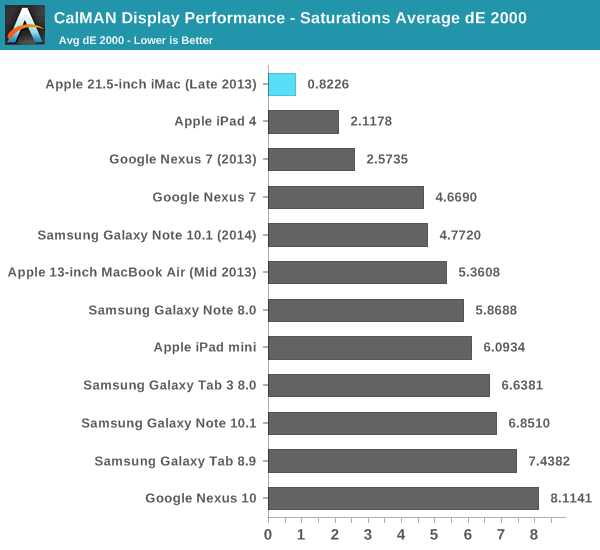
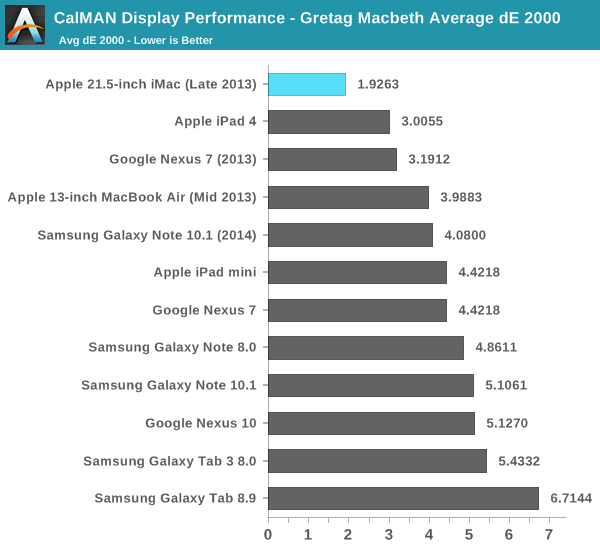

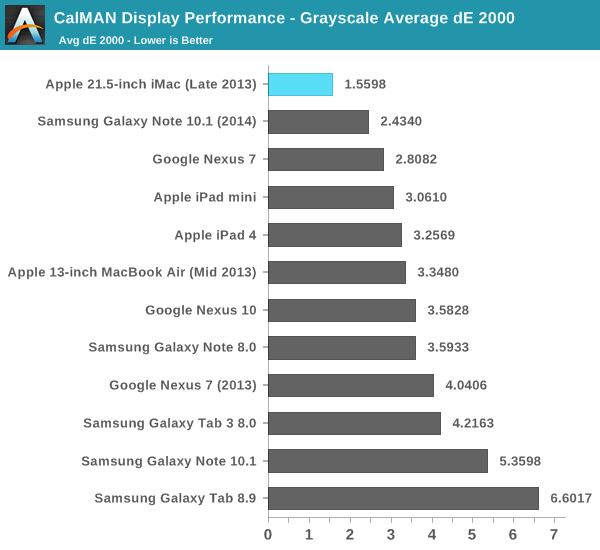
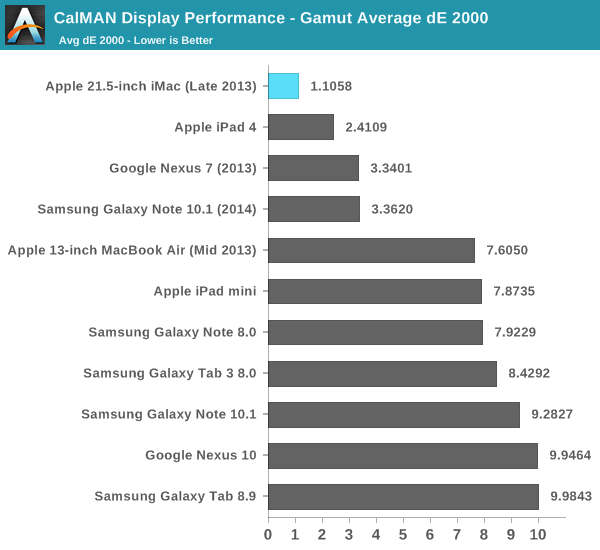

Although I doubt Apple’s intended audience for the entry-level 21.5-inch iMac are imaging professionals, they could very well use the system and be perfectly happy with it. Literally all that’s missing is a 2x resolution model, but my guess is it’ll be another year before we see that.
I have to point out that Apple does source its display panels from multiple providers (typically 2 or 3), not to mention panel variance within a lot. I don’t anticipate finding many panels better than the one in my review sample, but it’s always possible that there will be worse examples in the market. I haven’t seen huge variance in color accuracy from Apple panels, so I think it’s a pretty safe bet that what you’re going to get with any new iMac is going to be awesome.



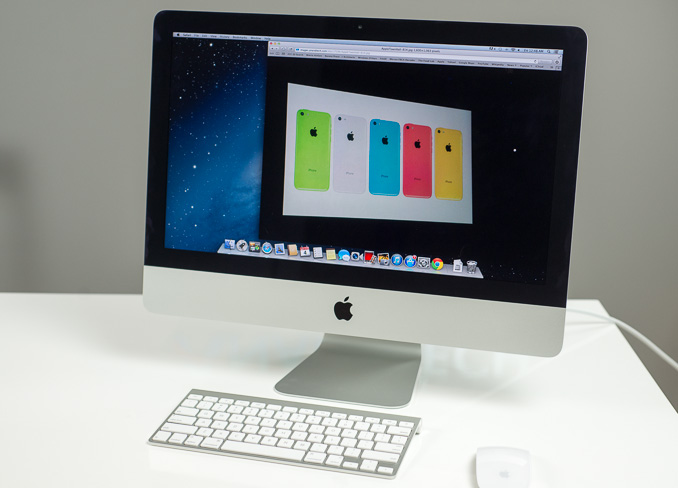











127 Comments
View All Comments
elian123 - Monday, October 7, 2013 - link
Also wondering when (and where) the 4770R will ever turn up.elian123 - Monday, October 7, 2013 - link
Well, one thing Google shows me is that Gigabyte has shown (though not announced) a Brix with 4770R: http://blog.laptopmag.com/gigabyte-brix-iris-graph... and http://www.pcgameshardware.de/CPU-Hardware-154106/...mavere - Monday, October 7, 2013 - link
I think it'd make for a pretty sweet Mac Mini.Penti - Monday, October 7, 2013 - link
Interesting to see were Apple wants their starting point to be.Obviously they don't want that much choice in their iMacs, still waiting to see what they do with their mac mini's too.
Can't help but wonder if you can actually separate the glass and LCD though, has anybody tried? What technique and adhesive does LG/Apple use here? Has anybody tried to run another LCD-panel from the newer iMacs (2012/13)? Older panels might actually be drivable, would be a paint to rebuild a new iMac for those though.
Dennis Travis - Monday, October 7, 2013 - link
Everything I have read says it's one integrated unit with the Glass/LCD together. I am also interesting and will keep looking but it does not look possible so far.Dennis Travis - Monday, October 7, 2013 - link
Oops Interested! :D GrinPenti - Monday, October 7, 2013 - link
It's sold as one unit, but obviously it's bonded with an adhesive, depending on how it might not be possible to separate the two. It should maybe be able to drive older iMac displays though. But those are a few mm thicker.Dennis Travis - Monday, October 7, 2013 - link
Knowing Apple you would probably crack the glass if you tried.Penti - Monday, October 7, 2013 - link
As it's gapless the adhesive covers the whole panel which probably ruins it anyway, or will be hard to clean as you can't really use (strong) solvents on the LCD, but it's fully doable on phones which also adheres the screens with adhesive. Would be interesting to know if that kind of adhesive can be loosened by heat though. Plus it would probably be harder then a small screen here.pdffs - Monday, October 7, 2013 - link
"I’ve heard some developers complain about this in the past, partly blaming it on a lack of lower level API access as OS X doesn’t support DirectX and must use OpenGL instead."Wait, doesn't OpenGL get you *closer* to the hardware than DirectX??